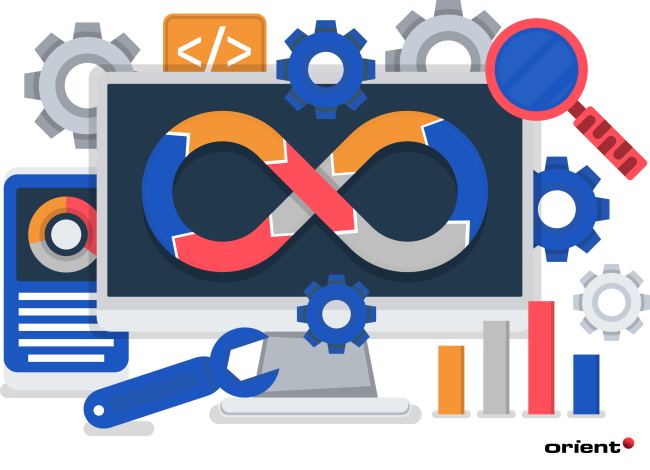DevOps Automation in Software Development: What Is It & What to Automate?

Content Map
More chaptersBusinesses of different scales have been turning to the DevOps culture to gain more business value in recent years. In 2021, it was reported that 83% of IT decision-makers adopted a DevOps culture. The following concrete numbers can explain the reason for the unstoppable rise of DevOps practice: In 2021, 58% of organizations witnessed better performance and ROI after implementing DevOps practices, 68% of companies reported improved end-to-end customer experience, and 47% of them acknowledged they shortened the time-to-market of their software and services. Obviously, the impact of DevOps in the software development industry cannot be overlooked, especially when automation comes in and changes the game.
What Is DevOps Automation?
The right DevOps tool can automate manual processes and speed up the software development life cycle (SDLC). But what exactly is DevOps automation?
In its simplest terms, DevOps automation is the act of utilizing automation tools and technologies in DevOps practices in order to perform repetitive tasks with minimal or no human intervention. This process automates anything in the software development lifecycle, ranging from build and deployment pipelines to automatic testing and monitoring. The idea behind the automation is to simplify the DevOps processes while still ensuring collaboration between the operation and development teams and secure high-quality outcomes.
There are multiple technologies that can be implemented in DevOps automation processes, comprising IT automation, infrastructure automation, robotic process automation (RPA), artificial intelligence, machine learning, deep learning, etc. In addition, there are currently also a variety of automation tools that a DevOps team should consider using, such as Puppet, Chef, Ansible, Jenkins, and many more. These technologies and tools utilized in automation are referred to as the DevOps toolchain.
Which DevOps Processes Should Be Automated?
With the DevOps tools and automation technologies in place, the development and operations teams can automate all the manual processes of the lifecycle. To be more specific, automation can target the following DevOps processes:
Testing
It is an important yet time-consuming and troublesome process, so the DevOps team should automate testing. This way, the DevOps team can create and run tests on the code in development faster and more precisely before it is deployed to production. This would help to ensure that the code is error-free and compliant with the required quality standards. In addition, automated testing can also be used to monitor the system for potential issues after deployment. Last but not least, automated testing can help the development teams minimize the human intervention in the testing process, thereby helping to avoid human error as well. Unit tests, integration tests, system tests, and regression tests are some of the tests that can be automated in the DevOps cycle.
Deployment
With DevOps automation tools, the development team can configure and set up an automated end-to-end deployment process in which the code changes are automatically deployed to production after being tested and approved. This process automation will ensure that the application or code changes are deployed correctly and consistently every time across the delivery cycle with minimal or no downtime. In addition, continuous deployment can speed up the process by minimizing manual tasks and reducing human intervention.
CI/CD
Continuous integration (CI) is the process in which developers integrate code changes into a shared repository frequently and automatically. This practice is used to catch errors quickly and early in the development process. On the other hand, continuous delivery (CD) is a process in which the code changes are automatically built, tested, and deployed to production after being approved. Both CI and CD are integral parts of the DevOps lifecycle, and automation can help to speed up and optimize these processes.
Provisioning & Configuration
In DevOps, infrastructure provisioning is the process of allocating and configuring resources for the development, testing, and production environments, while configuration management is the process of tracking and controlling changes to the system configuration. Both processes are essential for maintaining consistency across the different environments and ensuring that the system runs smoothly. With DevOps automation, these processes can be performed faster and more accurately. Automated provisioning and configuration can also help to keep track of the configurations of the different environments and ensure that they are consistent with each other.
Infrastructure Management
In addition to provisioning and configuration, the operations teams should also consider automating the management of the infrastructure. The ultimate goal of infrastructure automation is to reduce manual intervention in the process and better manage all resources in the development, testing, and production environments, such as the hardware, software, operating systems, data storage, etc. This includes automating the deployment of new resources, monitoring and managing existing resources, and scaling the infrastructure up or down as needed. Automated infrastructure management can help to ensure that the system is always running at optimal levels and that the different environments are consistent with each other as well.
Monitoring
In a DevOps pipeline, it is essential to monitor the performance of the systems continuously in order to identify any issues or errors quickly. This way, the development team can fix the problems before they cause any major impact. To do this, the DevOps team should set up an automated monitoring system that can collect data from various sources and provide alerts when something goes wrong. Continuous monitoring will help to enhance the overall quality of the system and prevent any major issues.
Log Management
This is a process of collecting, storing, and analyzing log data. In DevOps, it is important to have a centralized log management system in place so that the development teams can quickly identify and fix any errors. A good log management system will provide alerts when something goes wrong and allow the team to investigate the issue further. It will also help to improve the performance of the system by providing insights into the system’s behavior.
The Impact of DevOps Automation
The benefits DevOps offers are numerous, and they are empowered even more when the automation processes come in. Here, we will outline some of the top benefits you can reap from DevOps automation in general:
Better Productivity
First of all, having all the manual processes automated by DevOps tools and software will certainly result in higher productivity, and your development and operations teams are free up to prioritize other high-order tasks instead of wasting time on iterative and non-value-added tasks.
Reduce Human Intervention & Error
We have repeated over and over again in this article that automation does help minimize human input in every process of the agile software development lifecycle. This means that there will be minimal manual work and chances of human error in your DevOps workflow. Since the DevOps automation tools significantly reduce the need for human intervention, you are enabled to save human resources.
Faster Time-to-market
DevOps automation means all the processes, procedures, and updates in the pipeline are streamlined and automated. As a result, the time for development and deployment can be shortened considerably.
High Quality & Consistency
With all the time-consuming processes automated, your development teams can concentrate on other critical aspects that can help enhance the quality of the software, such as code reviews and testing. In addition, automated processes can also help to improve the consistency and accuracy of the results.
Greater Scalability
The DevOps toolchain and automated processes facilitate the ability to scale up or down as required since all processes are standardized and less resource-intensive. As a result, your organization can respond quickly to market demands without any significant impact on the overall budget.
So, Automate Your DevOps Processes Now or Never

In summary, DevOps automation is a vital part of the DevOps pipeline that helps to streamline the process and improve the overall quality of the system. It is important to note that automation in DevOps should not be used to replace the human element entirely. Instead, it should be used to support the teams and supplement the existing processes and make them more efficient. When used properly, DevOps automation can provide significant benefits to the organization, as we indicated above. Now, it is your choice to automate your DevOps processes and acquire the competitive edge for your business or be left behind.







